.
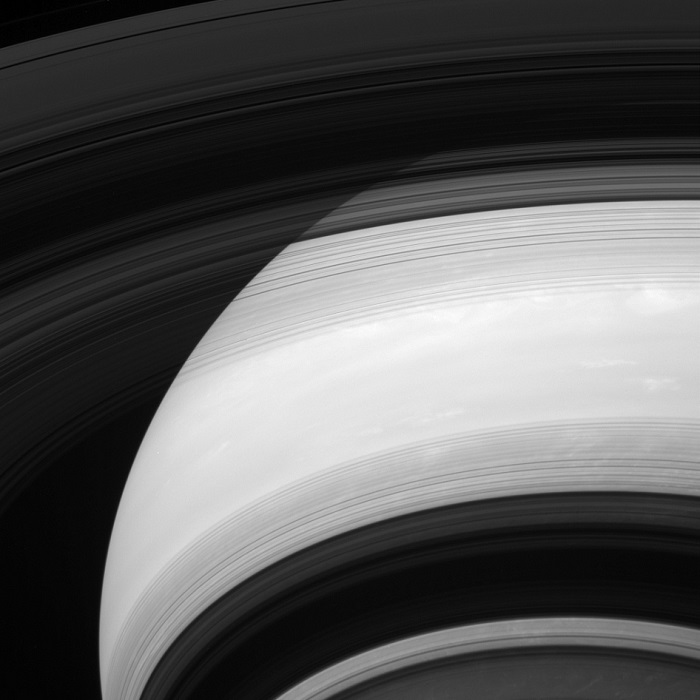
Saturn's rings cast shadows on the planet, but the shadows appear to be inside out! The edge of Saturn's outermost A ring can be seen at the top left corner of the image. Moving towards the bottom of the page, one can see the faint Cassini Division, the opaque B ring and the innermost C ring, which contains several ringlets that appear dark against Saturn in this geometry. The bottom half of the image features the shadows of these rings in reverse order superposed against the disk of the planet: the C ring, the B ring, the Cassini Division and the inner half of the A ring.
This view looks toward the unilluminated side of the rings from about 28 degrees below the ringplane. The image was taken with the Cassini spacecraft wide-angle camera on Dec. 2, 2013, using a spectral filter which preferentially admits wavelengths of near-infrared light centered at 752 nanometers.
The view was acquired at a distance of approximately 750,000 miles (1.2 million kilometers) from Saturn and at a Sun-Saturn-spacecraft, or phase, angle of 57 degrees. Image scale is 45 miles (72 kilometers) per pixel.
The Cassini-Huygens mission is a cooperative project of NASA, the European Space Agency and the Italian Space Agency. The Jet Propulsion Laboratory, a division of the California Institute of Technology in Pasadena, manages the mission for NASA's Science Mission Directorate, Washington, D.C. The Cassini orbiter and its two onboard cameras were designed, developed and assembled at JPL. The imaging operations center is based at the Space Science Institute in Boulder, Colo.
.
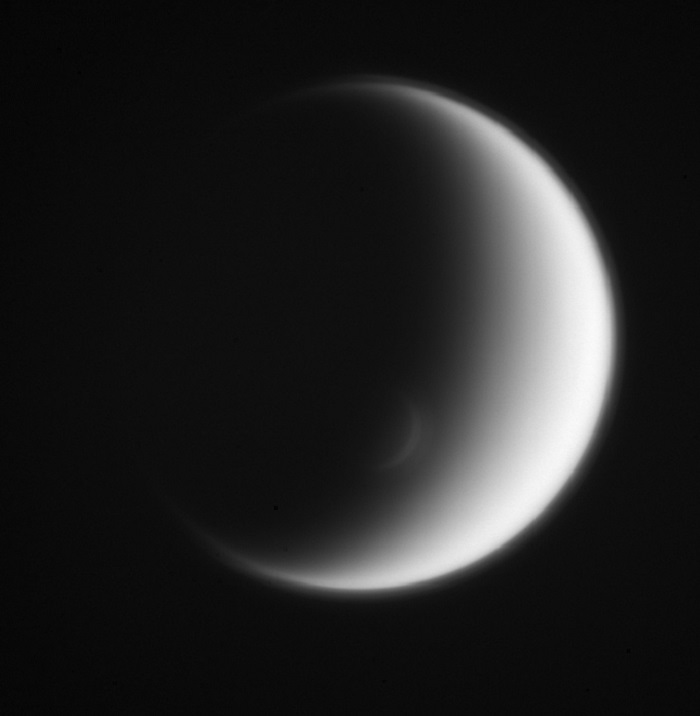
Titan's south polar vortex mimics the moon itself, creating an elegant crescent within a crescent. Situated above the surrounding polar atmosphere, the raised walls along the sunward side of the vortex just catch the grazing sunlight, creating a crescent of its own.Titan (3,200 miles, or 5,150 kilometers across) is Saturn's largest moon and possesses a dense and dynamic atmosphere. For a color image of the south polar vortex on Titan, see PIA14919. For a movie of the vortex, see PIA14920.
This view looks toward the trailing hemisphere of Titan. North on Titan is up. The image was taken with the Cassini spacecraft wide-angle camera on Dec. 1, 2013 using a spectral filter which preferentially admits wavelengths of near-infrared light centered at 939 nanometers.
The view was obtained at a distance of approximately 108,000 miles (174,000 kilometers) from Titan. Image scale is 6 miles (10 kilometers) per pixel.
.
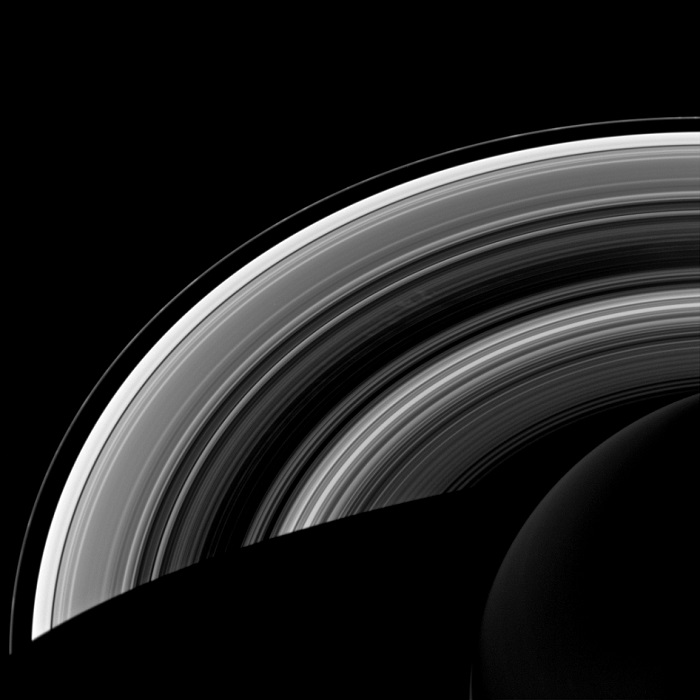
The spokes in Saturn's rings continue to be active and Cassini scientists continue to study them in order to unravel their mysteries. The spokes, visible near the center of the image, appear bright against the dense core of the B ring, which is the darkest section of the rings shown here in silhouette. Conditions favorable to the production of spokes are expected to wane as Saturn approaches its northern summer solstice. Scientists are eager to monitor the transition, the timing of which could yield valuable insight into the mechanisms that form these intriguing and ethereal features.
This view looks toward the unilluminated side of the rings from about 47 degrees below the ringplane. The image was taken in visible light with the Cassini spacecraft wide-angle camera on Oct. 19, 2013.
The view was acquired at a distance of approximately 1.2 million miles (1.9 million kilometers) from Saturn and at a Sun-Saturn-spacecraft, or phase, angle of 122 degrees. Image scale is 72 miles (115 kilometers) per pixel.
.
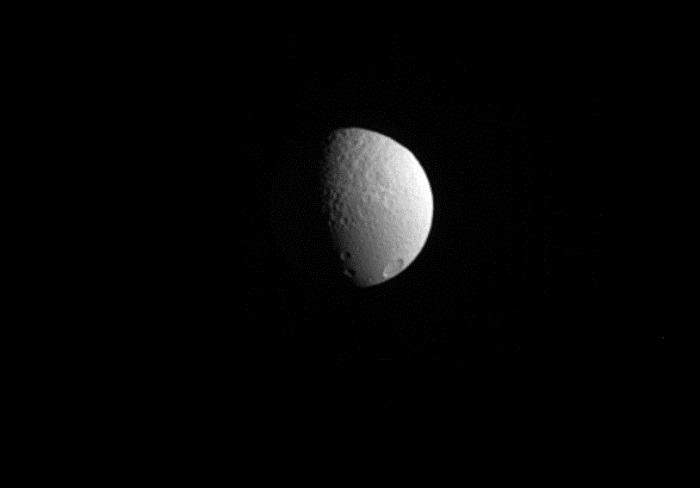
Tethys' trailing side shows two terrains that tell a story of a rough past. To the north (up, in the image) is older, rougher terrain, while to the south is new material dubbed "smooth plains" by scientists.
The smooth plains are roughly antipodal to the large impact crater Odysseus. Odysseus, which is on the far side of Tethys (660 miles, or 1,060 kilometers across) from this perspective, is out of view. (See PIA12588 for a view of Odysseus.) It's thought that the impact that created Odysseus also created the smooth plains, although exactly how this happened is not yet clear.
This view looks toward the trailing hemisphere of Tethys. North on Tethys is up and rotated 2 degrees to the right. The image was taken in visible light with the Cassini spacecraft narrow-angle camera on Nov. 27, 2013.
The view was obtained at a distance of approximately 1.1 million miles (1.8 million kilometers) from Tethys. Image scale is 7 miles (11 kilometers) per pixel.
.
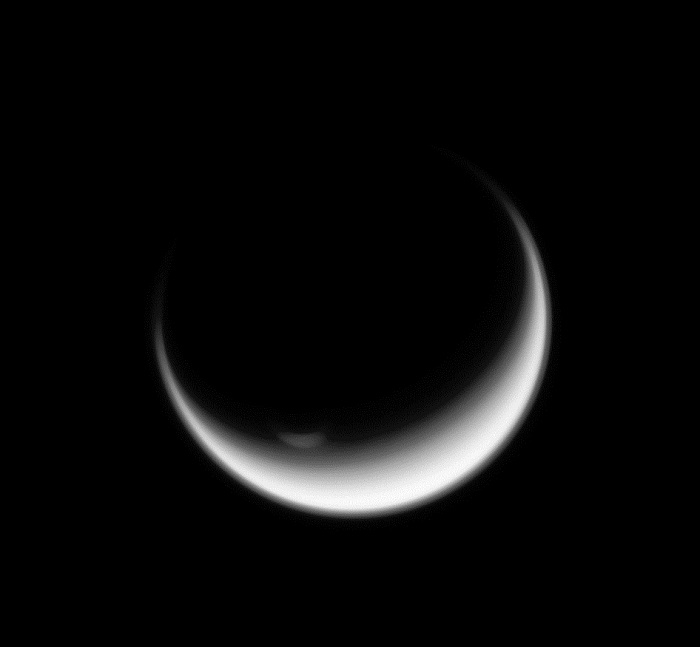
Titan's polar vortex stands illuminated where all else is in shadow. Scientists deduce that the vortex must extend higher into Titan's atmosphere than the surrounding clouds because it is still lit in images like this. Although the south polar region is now in winter, the Sun can still reach high features like the vortex.
Titan (3,200 miles, or 5,150 kilometers across) is Saturn's largest moon. For a color image of the south polar vortex on Titan, see PIA14919. For a movie of the vortex, see PIA14920.
This view looks toward the Saturn-facing hemisphere of Titan. North on Titan is up and rotated 32 degrees to the right. The image was taken with the Cassini spacecraft wide-angle camera on Feb. 3, 2014 using a spectral filter which preferentially admits wavelengths of near-infrared light centered at 742 nanometers.
The view was obtained at a distance of approximately 134,000 miles (215,000 kilometers) from Titan. Image scale is 8 miles (13 kilometers) per pixel.
Quelle: NASA
